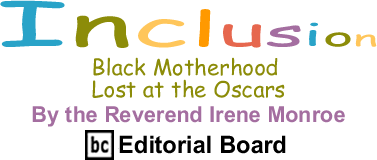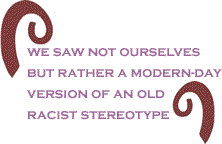
|
||||||||||||||||||||||
|
||||
 |
||||
The historical legacy of the devaluation and demonization of black motherhood was both applauded and rewarded at this year�s Oscars. And the point was clearly illustrated with Mo�Nique, capturing the gold statue for best supporting actress in the movie �Precious,� based on the novel Push by Sapphire, as a ghetto welfare mom who demeans and demoralizes her child at every chance she can.
The images of African-Americans parenting have historically been viewed through a prism of gendered and racial stereotypes. And the image of Mo�Nique as the bad black mother and Sandra Bullock as good white mother is not new. The images of bad black mothers have not only been used for entertainment purposes but also used for legislating welfare policy reforms. For example, in Ronald Regan�s era (1981 - 1989), black motherhood was constantly under siege. These moms were depicted as Cadillac-driving � welfare queens,� who had little to no ambition to work, wanted money for drugs and wanted to continue, due to their uncontrolled sexuality, to have illegitimate babies in order to remain on welfare. Reagan told a fallacious story about an African-American
mother from
The story of Precious takes place in 1983. And while the book shapes the character Precious and Precious� mom, Mary, within both the economic an cultural context of the Regan era, the movie �Precious does not. And this one-dimensional depiction of Mary conveniently reinscribes black mothers� fear that haunts us daily - we�re never good enough.
Lee Daniels, the director of �Precious� has a knack
for portraying monstrous black mothers on the silver screen. In this �post-racial� Obama era, the subject of race and the politics of black representation in films is constrained by neither political correctness nor moral consciousness. But Daniels would argue that the moral conscious of his �Precious� is evident not only by the film�s crossover appeal, but also by the universality of its message - the suffering and damage of child molestation at the hand of parents. While Daniels� film shocked and awed moviegoers across the country, many African-American sisters like Precious didn�t find the film as liberating and cathartic as intended. And much of the reason is because for many of these sisters, as with a lot of African-American women, we saw not ourselves but rather a modern-day version of an old racist stereotype. Some African-American woman told me they saw the character Precious as our culture�s new �Hottentot Venus.� Hottetot Venus was Saartjie �Sarah� Baartman from South African, who was forced to reveal her huge buttocks and labia to curious Europeans in a traveling human circus show. The Hottentot Venus has become the iconic image for portraying black female bodies as subhuman, and this image is still very much part and parcel of our culture�s social discourse. �Portraying African-American women as stereotypical mammies, matriarchs, welfare recipients, and hot mommas has been essential to the political economy of domination fostering Black women�s oppression, � sociologist Patricia Hill Collins writes in Black Feminist Thought: Knowledge, Consciousness, and the Politics of Empowerment. �Precious� is no doubt an important film. But when the artistic portrayal of the characters and people Daniels is trying to bring to life in a new way reinscribes century-old stereotypes, Daniels albeit with good intent, has caused harm.
BlackCommentator.com Editorial Board member, the Rev. Irene Monroe, is a religion columnist, theologian, and public speaker. She is the Coordinator of the African-American Roundtable of the Center for Lesbian and Gay Studies in Religion and Ministry (CLGS) at the Pacific School of Religion. A native of Brooklyn, Rev. Monroe is a graduate from Wellesley College and Union Theological Seminary at Columbia University, and served as a pastor at an African-American church before coming to Harvard Divinity School for her doctorate as a Ford Fellow. She was recently named to MSNBC�s list of 10 Black Women You Should Know. Reverend Monroe is the author of Let Your Light Shine Like a Rainbow Always: Meditations on Bible Prayers for Not-So-Everyday Moments. As an African-American feminist theologian, she speaks for a sector of society that is frequently invisible. Her website is irenemonroe.com. Click here to contact the Rev. Monroe. |
||||
 |
||||
If you would like to comment on this article, please do so below. There is a 400 character limit. You do not need a FaceBook account. Your comment will be posted here on BC instantly. Thanks. Entering your email address is not mandatory. You may also choose to enter only your first name and your location.
|
||||
Thank you very much for your readership. |
||||
| Any BlackCommentator.com article may be re-printed so long as it is re-printed in its entirety and full credit given to the author and www.BlackCommentator.com. If the re-print is on the Internet we additionally request a link back to the original piece on our Website. | ||||
| |
||||
March 11, 2010 |
| Executive Editor: David A. Love, JD |
| Managing Editor: Nancy Littlefield |
| Publisher: Peter Gamble |
| Est. April 5, 2002 |
| Printer Friendly Version in resizeable plain text format |
 |
 |
 |

|
 |
| |
| |


































 The
feeling that we, as mothers, are never good enough was also thrown
in our faces in Daniel Moynihan�s 1965 report �The Negro Family:
The Case For National Action.� This report, also known as the Moynihan
Report, states that the cause of the destruction of the Black nuclear
family structure was women, giving rise to the myth of �the Black
Matriarch.� The myth proposes that African-American women are complicit
with white patriarchal society in the emasculation of African-American
men by becoming heads of households and primary job holders.
The
feeling that we, as mothers, are never good enough was also thrown
in our faces in Daniel Moynihan�s 1965 report �The Negro Family:
The Case For National Action.� This report, also known as the Moynihan
Report, states that the cause of the destruction of the Black nuclear
family structure was women, giving rise to the myth of �the Black
Matriarch.� The myth proposes that African-American women are complicit
with white patriarchal society in the emasculation of African-American
men by becoming heads of households and primary job holders.









